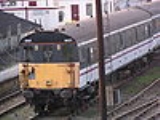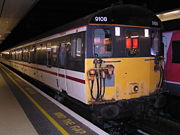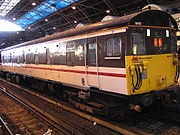
British Rail Class 489
Encyclopedia



British Rail
British Railways , which from 1965 traded as British Rail, was the operator of most of the rail transport in Great Britain between 1948 and 1997. It was formed from the nationalisation of the "Big Four" British railway companies and lasted until the gradual privatisation of British Rail, in stages...
Class 489 (or GLV) is a type of electrical multiple unit, specially converted for use on Gatwick Express trains, from London Victoria to Gatwick Airport.
The units were converted from Class 414
British Rail Class 414
The British Rail Class 414 electric multiple units were built between 1956 and 1963.209 of these two car units were built to two similar sub-classes. The first batch of thirty-six units were built on the underframes of older SR Class 2Nol units, and numbered in the range 5601-5636...
driving motors cars, by Eastleigh works in 1983-84, for use on the new Gatwick Express service. They were used to allow push-pull
Push-pull train
Push–pull is a mode of operation for locomotive-hauled trains allowing them to be driven from either end.A push–pull train has a locomotive at one end of the train, connected via some form of remote control, such as multiple-unit train control, to a vehicle equipped with a control cab at the other...
operations, on the London-end of the rakes of Class 488
British Rail Class 488
The British Rail Class 488 are unpowered trailer sets, converted from Mark 2F coaches for the Gatwick Express service from London Victoria railway station to Gatwick Airport....
stock, with a Class 73
British Rail Class 73
The British Rail Class 73 is a United Kingdom model of electro-diesel locomotive. The type is unusual in that it can operate from a 750 V DC third-rail or an on-board diesel engine to allow it to operate on non-electrified routes...
locomotive used for propulsion. The units were used as baggage cars.
Units were given unit numbers in the range 489101-489110, with individual carriages numbered 68500-68509. However, purely for aesthetic purposes, only the last four digits of the set numbers were shown, to fit with the traditional Southern style (maintained until privatisation by British Rail's Southern region) - older (pre-TOPS
TOPS
Total Operations Processing System, or TOPS, is a computer system for managing the locomotives and rolling stock owned by a rail system...
) units were originally assigned four-digit numbers. The units were originally painted in BR Blue/Grey livery, which was quickly replaced by InterCity livery. The final livery carried by these units is a variation of the InterCity livery, with a claret stripe and Gatwick Express lettering.
Operations
Upon privatisation of British RailPrivatisation of British Rail
The privatisation of British Rail was set in motion when the Conservative government enacted, on 19 January 1993, the British Coal and British Rail Act 1993 . This enabled the relevant Secretary of State to issue directions to the relevant Board...
, the Gatwick Express franchise was won by the National Express Group
National Express Group
National Express Group plc is a British transport group headquartered in Birmingham that operates bus, coach, rail and tram services in the UK, the US and Canada, Spain, Portugal and Morocco and long-distance coach routes across Europe...
.
Gatwick Express
Immediately after privatisation, the Class 489 fleet was exclusively used by Gatwick Express on all their London Victoria-Gatwick Airport shuttles. However, new units, in the form of Class 460British Rail Class 460
The British Rail Class 460 electrical multiple units were built by Alstom at Washwood Heath from 2000-01. These units are part of Alstom's "Juniper" family of units, which also includes Classes 334 and 458...
'Juniper' units were built from 2000, with the aim of completely replacing the old stock. By 2002, sufficient new trains were in service to allow six Class 489 units to be removed from traffic, leaving four units retained as cover in case of failure of one of the new trains. Two of these subsequently withdrawn so that by the end of 2004, only two units (nos. 489104/110) were still in use, as reliability of the 'Juniper' units had not improved sufficiently to totally replace all the old trains. They were finally withdrawn in 2005, following improvements to the "Juniper" fleet reliability.
Other operators
Since finishing with Gatwick Express, several units have been sold to other operators.FirstGBRf
FirstGBRf have purchased units 489105 and 106. These were part of a bulk purchase that included six Class 73British Rail Class 73
The British Rail Class 73 is a United Kingdom model of electro-diesel locomotive. The type is unusual in that it can operate from a 750 V DC third-rail or an on-board diesel engine to allow it to operate on non-electrified routes...
locomotives and numerous stock. The locomotives have now been returned to service, but the units have been stored at various locations, including Shoeburyness (Pig's Bay), Norwich Crown Point
Norwich Crown Point
Crown Point was originally the name given to an area within the city of Norwich in the United Kingdom.The name is now more commonly associated with the Crown Point Traction Maintenance Depot operated by National Express East Anglia. Intercity and Diesel Multiple Unit trains are serviced and...
and Peterborough
Peterborough
Peterborough is a cathedral city and unitary authority area in the East of England, with an estimated population of in June 2007. For ceremonial purposes it is in the county of Cambridgeshire. Situated north of London, the city stands on the River Nene which flows into the North Sea...
.
Network Rail
Network RailNetwork Rail
Network Rail is the government-created owner and operator of most of the rail infrastructure in Great Britain .; it is not responsible for railway infrastructure in Northern Ireland...
have purchased two units, 489102 and 109. They were stored for several years, but were returned to use in early-2006 as deicing and load-bank vehicles.
Preservation
Somewhat surprisingly, five units, representing half the class, have been preserved on heritage railwayHeritage railway
thumb|right|the Historical [[Khyber train safari|Khyber Railway]] goes through the [[Khyber Pass]], [[Pakistan]]A heritage railway , preserved railway , tourist railway , or tourist railroad is a railway that is run as a tourist attraction, in some cases by volunteers, and...
s. Two of the units in question were donated by Porterbrook Leasing
Porterbrook
Porterbrook is one of the three major ROSCOs in the United Kingdom...
in 2003 to the Ecclesbourne Valley Railway
Ecclesbourne Valley Railway
The Ecclesbourne Valley Railway is a long heritage railway in Derbyshire, the headquarters of the railway centre around Wirksworth station and services operate between Wirksworth and Duffield and Wirksworth and Ravenstor...
in Derbyshire
Derbyshire
Derbyshire is a county in the East Midlands of England. A substantial portion of the Peak District National Park lies within Derbyshire. The northern part of Derbyshire overlaps with the Pennines, a famous chain of hills and mountains. The county contains within its boundary of approx...
who now use one as a buffet car and the other a museum. A third unit, 489108 was bought by a Private owner for preservation at Nottingham Transport Heritage Centre
Nottingham Transport Heritage Centre
The Nottingham Transport Heritage Centre is a heritage centre based at Ruddington, Nottinghamshire, the terminus of the northern section of the Great Central Railway . The site includes locomotive and rolling stock workshops , as well as cafeteria and shops...
. It was sent for scrap in May 2009, being the second GLV to be scrapped. The final two units in use with Gatwick Express were preserved in early-2006.
- 489101 (68500) - Ecclesbourne Valley RailwayEcclesbourne Valley RailwayThe Ecclesbourne Valley Railway is a long heritage railway in Derbyshire, the headquarters of the railway centre around Wirksworth station and services operate between Wirksworth and Duffield and Wirksworth and Ravenstor...
- 489104 (68503) - Spa Valley RailwaySpa Valley RailwayThe Spa Valley Railway is a standard gauge heritage railway that runs between Tunbridge Wells, High Rocks, Groombridge, and Eridge railway station, where it links with the Oxted Line. En route it crosses the Kent and East Sussex border, a distance of 5 miles , along the former Three Bridges to...
- 489107 (68506) - Ecclesbourne Valley RailwayEcclesbourne Valley RailwayThe Ecclesbourne Valley Railway is a long heritage railway in Derbyshire, the headquarters of the railway centre around Wirksworth station and services operate between Wirksworth and Duffield and Wirksworth and Ravenstor...
- 489110 (68509) - Barry Island Railway
Fleet status
The final Gatwick Express units were withdrawn in 2005. Both of these units (nos. 489104/110) had been withdrawn in 2000 and 2001 respectively, but were overhauled and returned to use in 2002. They replaced units 489103/108, which were withdrawn from traffic as they were due overhaul.Network Rail returned its two units to service in 2006, following a period in store.
The current status of the fleet is shown below.
| Key: | In service | Withdrawn | Preserved | Scrapped |
|---|
| Unit no. | Vehicle nos. | Operator | Withdrawn | Status | |
|---|---|---|---|---|---|
| DMLV | ex-DMBSO | ||||
| 489101 | 68500 | 61269 | Gatwick Express | 2002 | Preserved |
| 489102 | 68501 | 61281 | Network Rail | - | In service (stored 2000-2006) |
| 489103 | 68502 | 61274 | Gatwick Express | 2002 | Scrapped (2003) |
| 489104 | 68503 | 61277 | Gatwick Express | 2005 | Preserved |
| 489105 | 68504 | 61286 | Network Rail | - | In Service |
| 489106 | 68505 | 61299 | Network Rail | - | In Service |
| 489107 | 68506 | 61292 | Gatwick Express | 2002 | Preserved |
| 489108 | 68507 | 61267 | Gatwick Express | 2003 | Scrapped (2009) |
| 489109 | 68508 | 61272 | Network Rail | - | In service (stored 2001-2006) |
| 489110 | 68509 | 61280 | Gatwick Express | 2005 | Preserved |

